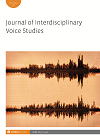
Full text loading...

Avant-garde electronic music purports to be abstract rather than representational. We are supposed to care only about sound qua sound, but what if the body is fundamentally audible in the musical work? Furthermore, what if the audible body is disabled? This essay pursues several close listenings of the avant-garde electronic works Visage (1961) and I Am Sitting in a Room (1969). Both pieces feature stuttering voices that are highly mediated by technology. Sounding out disabilities from traumatic to mundane, the works promote an aural staring encounter, asking listeners to grapple with the discomfort that they may hear.

Article metrics loading...

Full text loading...
References


Data & Media loading...

Publication Date:
https://doi.org/10.1386/jivs_00003_1 Published content will be available immediately after check-out or when it is released in case of a pre-order. Please make sure to be logged in to see all available purchase options.